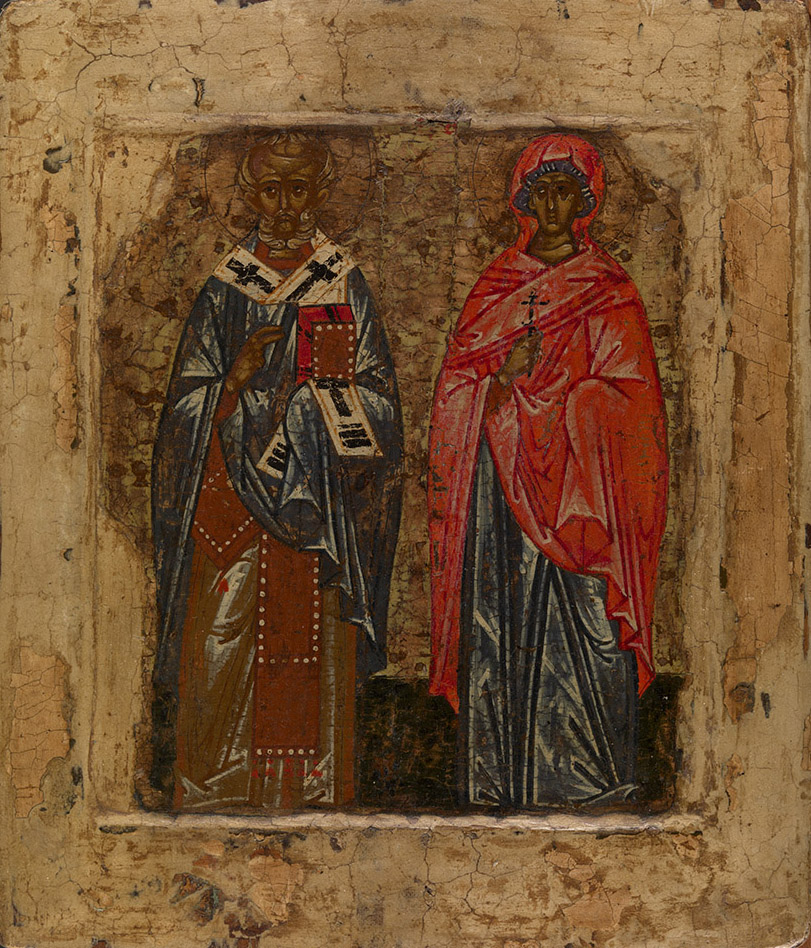MacDougall Auctions 2-3 December 2009
2 December 2009

5. AN IMPORTANT ICON OF SAINTS NICHOLAS AND PARASKEVA
NOVGOROD, MID TO THIRD QUARTER OF THE 15TH CENTURY, INSERT (VRESOK)
31.2 by 26.3 cm.
90,000-150,000 pounds
Related literature: For similar icons, see St Nicholas of Myra in Licea in the Examples of 12th-19th
Century Art from the Collection of the State Russian Museum, St Petersburg, 2006, cat. no. 18, p. 77.
E. S. Smirniva, V. K. Laurina, E. A. Gordienko, The Art of the Great Novgorod of the 15th Century, Moscow, 1982, cat. no. 24, 25, 38, 44. This work is a typical example of a Novgorodian icon from the middle to third quarter of the 15th century, and is a variation of a “selected saints” composition, particularly popular in Novgorod. The icon depicts the double image of Saints Nicholas the Wonder-Worker and Paraskeva Piatnitsa (“Friday”), the most venerated saints of the area. Many well-known examples of such a combination can be found in the collections of the largest museums in Russia, both as icons (e.g., a mid 15th century, two-tier icon with half-length figures of Saints Nicholas the Wonder-Worker, Paraskeva, Elijah, and Blaise of Sebastea (from the State Russian Museum), and as examples of the plastic applied arts, particularly as pendants and wooden sculptures. These two saints were often depicted together, since the broad areas of their patronage were very similar (agriculture, crafts, and trade); they were appealed to in all calamities, their intercession and patronage were sought by those injured or craving justice, and they were also regarded as healers and wonder-workers with the power to raise the dead. St Nicholas was known as a prompt helper in all things, whereas St Paraskeva was considered the patron saint of women at work, and of trade dealings – particularly important in the case of Novgorod, one of the largest centres of trade – hence the dedication of many churches in Novgorod to these two saints. The style of painting has numerous analogies with Novgorodian icon-painting of the middle and the third quarter of the 15th century, such as the characteristic face type, particularly recognizable by the shape and outline of the nose and lips, the slightly off-set glances, and the emphasised finger and wrist joints; distinctive impasto strokes of modelling; the colour-scheme based on bright, primary colours of blue-green and vermilion; and the depiction of light on the garments in thick white and coloured strokes, a practice which was usual for Novgorod. The most spectacular examples of this style are the “Selected Saints” and “Saints Paraskeva Friday and Anastasia” icons (both in the collection of the State Russian Museum). The tradition of the insert-icon bears witness to the careful preservation of 15th century images from Novgorod in Russian art and is well attested-to in various museum collections, such as the insert-icon with a half-length depiction of St Nicholas the Wonder-worker from the Andrei Rublev Museum of Ancient Russian Art or another panel with the figures of saints Paraskeva and Anastasia from the State Russian Museum. The fact that the older 15th century section was inserted in a 16th to 17th century panel, rather than an 18th to 19th century one as in the all other known cases, makes this icon unique and of significant museum and artistic value.
Notes on symbols:
* Indicates 5% Import Duty Charge applies.
Ω Indicates 20% Import Duty Charge applies.
§ Indicates Artist's Resale Right applies.
† Indicates Standard VAT scheme applies, and the rate of 20% VAT will be charged on both hammer price and premium.